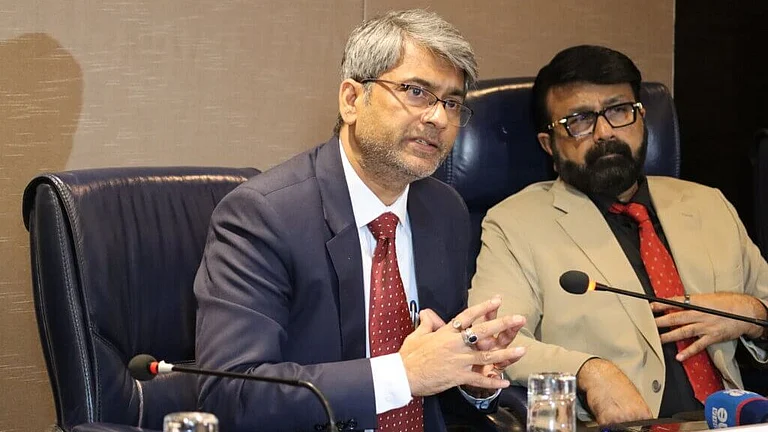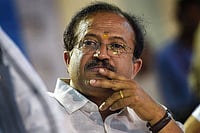FIFTY years. It is just a moment in the history of civilisation. But its a long period of time in the life of a nation-state. China has managed to become a dazzling star on the international horizon during that period. Between 1978 and 1992 the average annual growth rate of real gnp in China was almost 9 per cent, one of the highest, if not the highest in the world. Life expectancy has doubled. China has emerged as the largest recipient of foreign direct investment and it leads the world in exports. Over the last 25 years, industry has grown at a rate of over 10 per cent, agriculture by 4 per cent, grain output by 3.7 per cent. A fascinating performance by any standards. It does not have to be overemphasised that Indias performance is nowhere near this standard. A critic might well argue that new economic strategies have worked in China and that they have failed in India. Erstwhile Communists seem to handle capitalism better than the various Indian avatars of Fabianism.
We can claim that our polity is democratic and more human. All fragile polities can claim one advantage or the other. But we cannot realistically deny that newly emergent capitalism needs authoritarian political structures. Whether it is Thailand or South Korea, Singapore or Taiwan, Asiatic capitalism has been successful. But it has also been authoritarian. The advantage that we in India might claim on that score is illusory. The fact of the matter is that all early capitalism has boasted either of control of world resources or of authoritarian structures which make primitive accumulation possible. We did not resort to that politics. But it has left us woefully behind in terms of capitalist growth.
This, in any case, would be the unstated Chinese argument. Lee Kwan-yu of Singapore argues a similar case when he speaks of Confucian traditions and the uniqueness of Asia. Whether or not this reasoning is right, an authoritarian China has done immensely better than liberal democratic India.
In the next 25 years, Chinas gdp would have outstripped that of the United States ($20.004 trillion to $13.47 trillion). In per capita terms China would still be a poorer state for the simple reason that there are more Chinese to share that gdp than the Americans. It is clear that when we talk of China we are not quite talking of a state comparable to India. We are talking about a hugely prosperous, advanced stateover the next 25 years, that is. Gorbachev thought that he could not have his Perestroika without the Glasnost. The Indian attitude has been very similar to Gorbachevs. The Chinese seem to believe that you cannot go to glasnost without perestroika. The exact opposite. Of course, since the Narasimha Rao days it is not clear what we really believe in.
Indeed it is true that authoritarian or otherwise, China knows its mind. We do not. It is not my case that everything works or has worked in China. It is however my case that they seem to know what has to be worked. Their economic activity is controlled by the Chinese state. All decision-making is mediated through the state and the Party. The economy works because the politics is organised and dominant. The polity is not fragile. Stability is not in question. It is doubtful if even the worst detractor of China would find the picture in India better in these respects. Fifty years after independence the question of Indias integration is still an unresolved one. After three-and-a-half wars with Pakistan (half being the conflict over the Rann of Kutch) and the recent Kargil exercise we are no closer to normalisation of relations with Pakistan or to the confirmation of Kashmirs status. The Chinese are sitting pretty on the frontier. The status quo on the frontier can be changed now only with mutual consent. That is the India-China border. Kargil demonstrated that the same thing cannot be said of the India-Pakistan border. We live in an ocean of discontent when it comes to us and our neighbours. China hasnt had a conflict with its neighbours for more than two decades. (The last one was with Vietnam.) China has 14 neighbours. We have less than half that number. We are pre-eminent in South Asia. That, however, seems to be a function less of our policies than of our size. There is a difference between being big and being great. China has managed to be both in its neighbours eyes. We have not.
This is not to say that we have not become a regional power over the last 50 years. We certainly have. We have put our relations with Sri Lanka after "the time of terror" there on an even footing. This is just an example. Not all problems with Bangladesh can be blamed on Delhi. The Taliban and its fundamentalism in Afghanistan have been an American creation. It would be some time before the religious revolutionary zeal there dies down. No revolutionary zeal lasts forever. Religious zeal will meet the same fate. The Indian record thus is not entirely disappointing. But that still does not mean we are in a post-conflict situation with our neighbours. China clearly is. Over the 50 years, in Chinas case hostile relationships have turned into at best friendly relationships, and at worst relationships of manageable tensions. We continue to plod towards an uncertain future.
Towards the end of the Fifties, Khruschevs Soviet Union declined to aid and assist Chinas independent nuclear device. The result was China decided to go it alone. In 1964 the Chinese nuclear device went into air and quite coincidentally Khruschev went down. Indira Gandhi decided to take her first faltering steps towards nuclear power in 1974 (Pokhran I). It has taken us a quarter of a century to take the next. Twenty years since Pokhran I, 30 years since (the Chinese explosion at) Lop Nor.
There will be endless debates on the need to go nuclear. There need not be any on the mystifying slowness in our decision-making. When it comes to power, the Chinese react with alacrity; Indians almost do not know their mind. Six explosions over 25 years. No, this cannot be the way of going nuclear. I have a sneaking suspicion that the Chinese are not angry about our nuclear power. They are contemptuous. Whatever the liberals might say we ride no nuclear tiger. They do. We ride at best a nuclear cat. Or to put it differently, we have a "minimum credible nuclear deterrent" to borrow the expression of the draft nuclear doctrine. We only have a minimum credible nuclear doctrine! China has weapons, we have a draft doctrine. We have very fine arguments and rhetoric in terms of neo-realist theory of international relations. China has a neo-realist worldview and the power to go with it. We live in times of crumbling state structures and fundamentalist forces all over Asia, from the Mediterranean to the Indian Ocean. India and Pakistan have suffered from that. Religious fundamentalism produces clerical fascism, as in Iran or Afghanistan. The state crumbles under its weight as it has in Afghanistan. China has managed to keep those tendencies under control.
Generally speaking, China has handled, at times by accommodation, at times by repression, all divisive tendencies. Our Centre has tended to be increasingly suspicious of provinces. The pathetic state in which the Congress finds itself is the most marked consequence of this. Fifty years gone and Indias Grand Old Party looks threatened. Fifty years gone and the cpc is as strong as ever. China has left personality cult behind. Congressmen have turned personality cult into a family cult. The living, the newly-born and perhaps yet-to-be born members of a family are worshipped by senior leaders of a senior party. There is something pathetic about this abject fall of a party. Even the Indian communists think that the party of the family cult can be their ally in the fight against communalism. Party structures are disintegrating in India. They are consolidating in China.
Fifty years. It is a long period of time. If in this period the Chinese have moved 10,000 Li (the Chinese mile) we have moved about 10, or perhaps a thousand. But thats all. It has been a proverbial case of the hare and the tortoise.
(Prof G.P. Deshpande teaches contemporary China at the Jawaharlal Nehru University.)


























